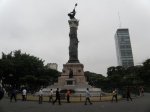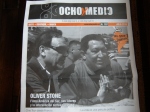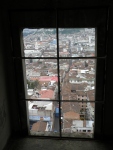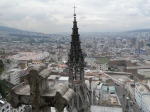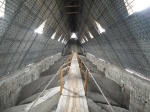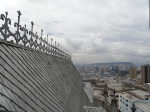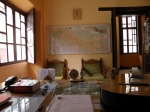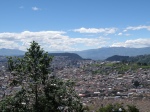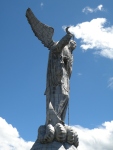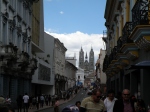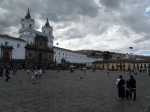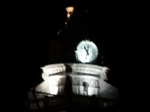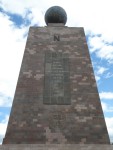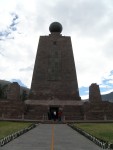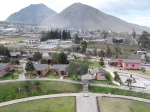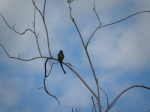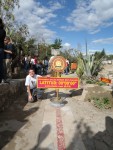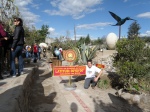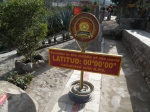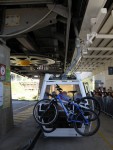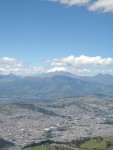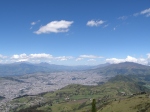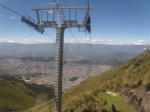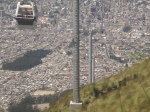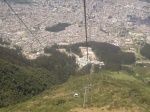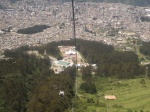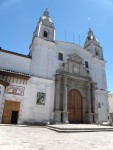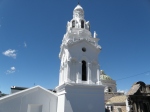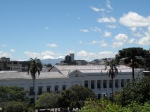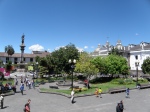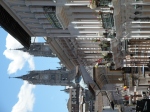- Cathedral, Plaza de San Francisco, Guayaquil
- Basilica del Voto Nacional
- La Posada Colonial, Quito’s Old Town
- Quito’s Old Town
- El Panecillo
- Quito
- La Virgen de Quito
- Catedral Primada de Quito, Plaza Grande
- Monastery of San Francisco
- Cotopaxi
- Mitad del Mundo
- Museo Solar Inti Ran
- Basilica del Voto Nacional
- Cotopaxi
- Quito, Ecuador
- teleferiQo, Quito
- Arco de la Reina
- Palacio del Gobierno
Chapter 21: Quito, Ecuador.
Tuesday, July 13
We’d reached the Ecuador entry point three kilometres beyond the Peruvian exit station. It all seemed a bit strange and baffling. Why weren’t the two countries’ officials working more closely? The passengers lined up for papers to be checked. It was late in the night, but an expectant atmosphere prevailed. A happy Spanish family was in front of me, but the smiles suddenly disappeared. The teenage daughter had her exit visa refused. The immigration official behind the glass window refused to acknowledge a viable exit stamp. It was looking far too faint for his eyes and those of his colleagues. The family’s pleas fell on deaf ears. The rest of us weren’t amused by this unnecessary action. It was totally unfair. Also, if the border officials on both sides were in closer proximity the matter could have been verified there and then. Our bus driver insisted we had to move on. We were all very sorry to leave the family though, but hopefully they would be able to negotiate a later entry.
It was hot and steamy night. The side door remained open to allow some freshness into the stuffy bus. I kept nodding off and then waking up with a jump. Mental and physical spaces became distorted in those brief moments when one wasn’t neither here nor there. A fidgety lady sitting opposite insisted on trying out different seats to suit her comfort needs. The bus approached Guayaquil, the largest city in Ecuador, at just after 9am. I bade farewell to the Dutch boys as I entered the large, futuristic looking bus terminal on the edge of town.
Drizzle fell from a leaden sky on a very warm and muggy morning. Inside the terminal, frantic shouts from bus ticket agents ruffled my tired senses. I looked for connections up to Quito. I approached one group of particularly aggressive sellers. They were literally bawling at me. I asked them about Quito buses, and they immediately calmed down and pointed out the relevant kiosks. I paid $18 for a night-time bus and left my luggage with the desk people. With time to spare I decided to check out Guayaquil’s centre. Extreme tiredness affected my concentration, but I eventually found an urban bus which took me into town for just 25 cents.
The US dollar became Ecuador’s official currency back in 2000 amid considerable public protest. I had a few notes left from the start of my journeys. There were hardly any gringos in the terminal, and I saw very few in Guayaquil’s city centre. A couple of old men helped me with directions when I stopped to ask them for ways to the cathedral. They laughed a lot but helped a great deal more and waved me a friendly salute as I headed away across a big plaza. I was almost sleep walking and there was another night-time bus to come. These would be my first back-to-back night journeys.
It was a real transit sort of day, but I gladly checked out Guayaquil. The commercial centre looked very clean and pretty. The amazing stained-glass windows of the church of San Francisco and the cathedral were a cosmic sensation. I stopped for an ice cream at a kiosk next to the dazzling Clock Tower in the touristy Malecon 2000. Wooden debris floated in packs on the Rio Guayas. I nuzzled my way in tiredness through the oppressive heat and eventually found an air-conditioned internet cafe. After a KFC meal back in the terminal I experienced an acute, salt induced thirst. I read more of Dara O Briain’s book, where he recounted his visit to a Ken Dodd show. His subsequent interview with the Liverpudlian comedian really lifted my mood.
I had hours to spare in the terminal and counted the minutes. I walked about in a zombie state, checking out the supermarket prices and working out the dollar value in Ecuador. I sat in a departure lounge where the overhead television replayed the same old promotional stuff. I could, and should, have kept my guitar with me to while away the hours. After another internet session the hour approached. I collected my luggage and made for the top floor platform where a full bus departed just before 11.
Wednesday, July 14
Midway through the journey up to Quito I had my knee grabbed by an elderly man sitting beside me. I sprang out of my slumber with a startled expression. However, the man seemed to be deep asleep. He kept murmuring a lot throughout the trip. It did alarm me, and I remained awake for the rest of the night. I had to be very wary on the night-time buses. The passengers in front seemed less suspicious and exchanged some small talk with me. It took eight and a half hours to reach the 2,800 metres high city in the rain clouds. The winding roads on the ascent to Quito left me feeling quite disorientated.
Quito had many dangers according to the Lonely Planet guide. I took a taxi into the new town district of Mariscal. The fresh breeze and the early morning sun perked me up a little. The stunningly steep green hills of Quito were a marked contrast to the arid surroundings of Cusco. The taxi driver struggled to find the recommended Hostal New Bask. We were close by, so I stepped out to locate it. I struggled to get my bearings but soon found the hostel further along the street.
After quickly checking in and depositing my passport and wallet in the hostel safe, I was in bed by 8am. However, there was a young crowd just waking up in the dormitory. They were a couple of Colombian cousins, another Colombian and an Ecuadorian from the south of the country. They seemed friendly enough and even offered me a smoke. It smelt nice, but I was already struggling to stay awake! They noticed my guitar though, so I played a few tunes for them before collapsing!
I woke up four hours later determined to visit the old town. I began walking up Reina Victoria, but it was the wrong way. Lack of sleep must have affected my navigation skills. I turned back and crossed a few blocks and checked my directions at a newsagent. A lady there kindly directed me onto Avenida 10 de Agosto. It was straight drag down into the old town. I’d certainly experienced South America’s contrasts of climate over just three days. From the sun drenched Mancora to the hot and humid Guayaquil and finally, to the cool, almost British like skies over Quito.
The clouds descended over the big town and the surrounding hills disappeared under a thick white mist. It was a very atmospheric environment. I became quickly absorbed by the fascinating look of Quito’s old town. It became a Unesco World Heritage Site in 1978 when workers began to renovate its colonial splendour and restore the historical centre to what it is today. It was the town to impress me the most since my arrival in South America. There was something quite authentic about the place. I wanted to stay in the historical centre to really sample the feeling at close hand. I enquired at a couple of places. Some of the Lonely Planet information was so outdated but it listed the still open La Posada Colonial. I was greeted by an extremely polite gentleman called Jaime. He had owned this establishment on Parades for many years. I promised to return.
Under an increasing deluge I returned up to the new town before dark, and before the supposed bogey men of Quito appeared. I needed to get out of my wet clothes and take a shower, but the hostel owner was painting the bathroom. Nevertheless, he afforded me the privacy to use the cubicle at the back of the room as he continued his work. The old guy seemed so subdued and fixed onto his immediate tasks. He seemed to reflect the very understated personality of Quito’s citizens I’d met thus far.
Thursday, July 15
My top bunk mattress was rather lumpy, but I had a good night’s sleep. Roommates Tatiana and her younger, baby-faced cousin, Johan, seemed a cute duo. Both from Bogota, Tatiana led the way with her artisan work taking them on travelling adventures around South America. She showed me a colourful wrist bracelet which I gladly bought. The hosts didn’t seem to mind the smoking but perhaps the ongoing painting work hid the smell. They served up fantastic breakfasts but took their time to respond to any other requests. The pace of Quito was equally slow as pedestrians strolled along in a high-altitude rhythm.
I took no chances with the weather and prepared with an added waterproof for my rucksack. I returned to La Posada Colonial to book a single room. It was only $6 per night. I tried out the Nuevo Cordovez for lunch and enjoyed a pleasant pasta dish. On the walls there were framed pictures of bullfighters, Latin American musicians, Hollywood legends and David Beckham in his Real Madrid strip. I later walked up past the university to the modern, artsy picture house Ocho y Medio to watch a film. I opted for Oliver Stone’s Al Sur de La Frontera (South of the Border). I quite enjoyed it but would have liked Stone to interrogate Venezuela president Hugo Chavez a little more. However, the film did stand up. It clearly explained the United States’ and International Monetary Fund’s involvement in Latin America. Much of the film’s dialogue was Stone’s spoken English with Spanish subtitles.
I returned to the hostel and caught up with Tatiana. She was preparing to leave later in the evening for a journey to the west coast but was short of money though. The subject cropped up while she packed her case in the dormitory. I think she was struggling to sell her arts and craft work. The recent heavy rains in Quito had made it difficult for her. She wanted to move on to warmer and drier regions to increase trade. We had a nice little conversation and she showed me photographs of her family and her hometown of Bogota. She had a gentle but sassy nature.
The dormitory was quiet and empty when I returned from the common room later in the evening. There was a knock on the door shortly after. It was Tatiana. She came in and we sat together on the lower bed. She asked me if I liked her. Her eyes opened wide to ask if I knew what she meant. I certainly did, and admitted how attracted I was. She said she felt the same about me and we started kissing. Suddenly there was another knock on the door. It was Johan. Tatiana told him to wait downstairs. She explained to me about needing money to cover her stay at the hostel. I decided to help both her and Johan with $12, but the alarm bells started ringing. I wasn’t sure but thought it was no big deal. Travelling was also about helping people out.
We left the dormitory and popped to a nearby disco bar to enjoy a few Club beers. Then Tatiana asked if I wanted to return to the hostel for a smoke. We spent a quiet moment together in the dormitory. There was always the likelihood of others coming into the room though, so we remained discreet and didn’t get too carried away. It was late evening when we went back out again.
By midnight we all returned to the dormitory. Johan was behaving differently towards me by now as was the Ecuadorian guy who seemed a little drunk and somewhat aggressive in his manner. Johan and Tatiana were exchanging quick-fire chatter and occasionally glancing over at me. I felt something was up and that I was being duped. They no longer seemed the innocent young pups on a travelling adventure but almost a Bonnie and Clyde duo dreaming up a scam.
Another roommate Alex, from Sweden, eased the tension. He was a keen guitar player and quite eagerly borrowed my guitar to play some riffs. I really enjoyed his playing. He had a nice technique, finger picking the top three strings using D chord variations and moving up and down the fret board. A while later an Argentine guy from Buenos Aires called Lucas arrived to stay for the night. I soon passed my guitar to him, and he proceeded to play some beautiful tango tunes. He instantly relaxed the atmosphere further. One by one, we all sunk into our sleep. The guitar had come to my rescue because I knew things were not right with Tatiana and her cousin.
Friday, July 16
After settling the charge for my stay and one night for Tatiana and Johan I returned to the dormitory. I was happy to help, more so if someone appeared genuine. The others were waking up. I quietly finished my packing and headed out onto the landing where Tatiana followed me. I said I was leaving. I assured her that I’d paid for her one night which she thanked me for. I then gave her the address of my new hostel in the Old Town. Was I really feeling that lonely? Perhaps she was genuine after all. Anyway, she promised to call and see me in the afternoon. I went downstairs to wait for my taxi. After the previous night’s smoking and drinking, I felt a bit bleary eyed.
When I arrived in the Old Town, I realised I’d forgotten to hand in my hostel keys. So, after breakfast I walked all the way back up Avenida 10 de Agosto then back down to the Old Town again. Along the way, I diverted onto Avenida Venezuela for a closer look at the imposing, towering presence of Basilica del Voto Nacional. To say this church stood out was an understatement. It was a giant of a building. Some city centre structures really do pierce the skyline, but some like this one have presence as well. For $2 I experienced an incredible hour climbing its stairs to ever higher vantage points overlooking Quito. I felt so tiny in such a huge structure. Between the basilica and the belfry was an interior plank to walk along. It looked quite precarious, but nothing compared to the outer steps to reach the belfry. One misplaced foot would lead to a mighty fall and certain death. I took deep breaths, gulped a great deal, and imagined how King Kong must have felt when clinging to the side of the Empire State Building! I literally crawled around the highest point. I’ve never experienced vertigo but I felt on the verge of some sort of panic attack for a few moments here. I’d experienced something similar with bridge phobia over the past three years. It was ever since I almost freaked out when driving over the Queen Elizabeth II Bridge, Dartford in 2008. I often think whether what I experienced in Hillsborough might play its part in recent issues with bridges and heights. Post traumatic stress symptoms can be delayed for years.
Once safely down from the terrifying nerve towers I felt somewhat elated to have been up there. The upper parts of the Voto were usually closed off for safety reasons and I could see why. I made my way back to La Posada Colonial. Jaime, the proprietor, had for the last 15 years spent Mondays to Fridays behind the desk of this grand old building. He asked if I were interested in reception duties over the weekend, so he could spend some time with his son Michael and the rest of the family. I thought, why not. It would be a pleasure. It was also nice to be asked, and for someone to show this much trust in me.
I settled in my room. Then Jaime called to say a young woman was on the phone. It was Tatiana. She arrived at the hostel shortly afterwards and came directly to my room all alone. We embraced and kissed. She smiled and then suggested lots of sex if we met up again, in Buenos Aires! I laughed and said maybe. Then the subject of money cropped up again. Tatiana wanted $30 to pay for bus tickets to the west coast. The same old line was becoming a bit boring. Without getting wound up, I spoke honestly with Tatiana and asked her to stop the charm offensive. I handed her a $10 note and escorted her out of my room. The smiling Johan greeted us in the foyer. He must have been right beside my door listening in. They were a couple of opportunists, nothing more really and not too nasty, but they were becoming a nuisance and I’d lost trust in them. I wished them luck as we walked to the entrance and past a bemused looking Jaime. He later explained how some Colombians hassled Europeans for cash and reckoned I’d handled the situation well. Jaime later showed me around the hostel, noting the vacant rooms. There were security procedures at the front of the house, and he indicated which doors to double lock.
Heavy rain lashed down as I dashed to a nearby internet cafe. The thick cloud enhanced the gloom as night fell quickly over Quito. The Old Town streets were no-go areas for foreigners after 7 in the evening. I stayed in my room reading and occasionally looking out of my east facing window. It faced up towards the brightly lit La Virgen de Quito statue on El Panecillo (Little Bread Loaf) hill. I smiled and reflected on how this aspect mirrored the view I’d always had of Old St Peter’s Church in Llanbedr Dyffryn Clwyd.
Saturday, July 17
La Posada Colonial was a nice old house. It had lots of old-fashioned charm. There was a such a reassuring, retrospective atmosphere about the place. The old-style windows, door locks and latches displayed an elegance of times gone by. The creaking floorboards just added to its character. I showered and shaved to look presentable. I now relished the opportunity to experience hostel life on the other side of the reception desk. Jaime was up and about. He pointed out a few more things. Only the first-floor rooms were available.
A French couple had left first thing followed by a friendly Dutch couple who kindly left me a bunch of bananas. I’d been to the supermarket to stock up on essentials. I had all that I needed including a large bottle of Tesalia mineral water. I kept drinking plenty of fluids. The mineral water, from the Cielo brand in Cusco to Tesalia in Ecuador, was fine to drink. It was also very cheap. A New Zealand guy and his travelling buddy from Holland later went out for the day. The hostel’s copy of the Lonely Planet had all the Quito pages ripped out, so I lent them mine. Jaime left at 9am. He promised to ring on Sunday to see how I was. He also left me a contact number just in case. Under no circumstances was I to allow anyone in without first establishing that they were tourists. With some light humour he also advised me to watch out for the Colombians!
Throughout the morning I caught up with my Spanish studies, carefully going through my exercise books. The front doorbell rang four times in about two hours. Different couples were wanting a room for obvious reasons. The hostel seemed to be the place for extra marital dalliances. I had promised Jaime, but all the same I felt lousy. The first couple were well in their sixties and the chap even offered me a $20 note. Were my killjoy antics an overreaction to Jaime’s advice? Man, I could have opened my very own pleasure palace for the weekend! I could have let them use the same old room, at different times of course, for their bit of fun. However, I had money in the safe to consider and the welfare and well-being of the other guests.
There was an old stone washing platform in the backyard, so I got to work on my clothes using tap water, a brush, and some soap. There was a long clothesline to dry them out on, but it began raining soon after midday. It was a very quiet day, apart from the blaring English rock music from a couple of cafes further up the street. I watched some football on the portable black and white television. I also practised some guitar rhythms in time to the large ticking clock on the opposite wall above a big, framed map of Quito. Jaime kept the inner doors locked all day. The glass frontage allowed one to view any visitors. The large wooden outer doors at the bottom of the entrance steps had to be locked after 7pm. There were two key locks and three large bolts to shut out any trouble.
Two Dutch guys arrived in the early evening followed by two young men from Israel at about 10pm. To be sure, I just popped my head out of the upper window in reception to check their credentials and clarify that they were who they said they were. In this case, Roni and Shaked from Tel Aviv, who were taking a long vacation up to Colombia. I showed them their room and took down their details before they went out for some dinner. They soon returned. The doors were secured, and I sat there in the quiet reception until midnight. There was an eerie silence inside and outside, but I felt at home.
Sunday, July 18
I slept quite soundly in my room. The doorbell hadn’t rung all night. All was well and I just had one more night of duties. Jaime gave me my room free of charge over the two nights. After rising at 7am I checked the place was safe and secure. There was lighting, door locking and window shutter procedures which Jaime entrusted upon me. It was a simple plan to follow though. My damp clothes were soon out on the line and drying quickly. The hot sun was quickly taking the chill out of the air. Jaime’s clothes were also hung back on the line after getting a soaking from Saturday’s rain. The hostel wasn’t serving breakfast during this out of season time, but I was there to be called upon. The Israeli guys were looking for Old Town maps. They already had the 2007 Lonely Planet, but I found a foldaway map with lots more information for them.
Sunday was the day when the Old Town district became traffic free. I still heard motors running on the streets below though. I like Sundays. I’m not a deeply religious man but one day of the week is great to set aside and seek some space to rest and reflect. It always seemed to be the day to feel the here and now and the presence of one’s immediate surroundings. I always took a step back to notice what lay there about me, without being cluttered and flustered by too much haste, information, and objects.
I thought of a line to describe Saturday…. spontaneous lover makers zapped by the fun haters! Was I being too harsh on myself? I never ever wanted to spoil other people’s fun. Other people’s happiness was always a light to seek out if one felt shrouded by gloom. When I worked in Glyndwr District Council in North Wales back in the early 1990s a colleague argued that man took great pleasure from others’ misfortune. He explained that it was the innate nature of man to envy or even be angered by others’ enjoyment and happiness. I disagreed with this conservative mindset and insisted that our thoughts were far more complex than such singular Schadenfreude attitudes.
In the hostel I had time to think. My thoughts floated through to the polar opposites of extreme rationality and recklessness. Personally, these competing wings affected my character. They made me so scared to step out of line. I never wanted to disappoint people. My former boss at a snack food factory in Ruthin once mistook this as a vanity-type weakness, accused me of being worried more about what people thought about me. He threw this accusation at me after I’d called him a mean old so and so. He’d rejected my request for holiday entitlement in line with the European Working Directive. As a small business he wasn’t legally bound by this though. We patched up our differences. I liked to please others, but I took a dim view of people being trodden upon. It was as simple as that in our little corner of Wales. A century’s worth of suppression had seriously damaged the Welsh language.
The minutes dragged on in the hostel. I felt grounded and I wanted to go places. As hollering vendors broke the tranquillity of the side streets, a shifty looking young guy came up the steps to the glass doors and rang the doorbell. He was from Colombia. I told him the hostel was full (lleno). Jaime telephoned and I later carried on learning some more basic Spanish sentences. The television news reported heavy snowfalls in central and southern Argentina. Hoping there were no later arrivals, I called it a day at 11. The Israeli guys were leaving early next morning and wanted a wake-up call at 6am.
Monday, July 19
The Israelis slept in till 7.30am but a Dutch guy and his English girlfriend, both nature enthusiasts, had earlier checked in. Jaime arrived back with his son Michael at 9. They’d enjoyed a marvellous weekend of horse riding and other family stuff. I informed him that the weekend takings totalled $88. Jaime was pleased. He said it was worthwhile keeping the hostel open and rewarded me with an extra free night and breakfast. I was in a happy mood after making myself useful. The hostel duties had boosted my confidence.
I wanted to spend the next few days exploring more of Quito. The town intrigued me. I bartered with a couple of taxi drivers for a cheaper trip up to El Panecillo. They both quoted $5 for a one-way ride to what seemed so close by. However, the zigzag route to the top and the stairs at the end of Garcia Moreno are unsafe. This Lonely Planet warning was confirmed by Jaime. Once I managed to wangle a $2.50 fare, I reached the top and admired the aluminium statue of La Virgen de Quito. There were amazing views over Quito and the surrounding white peaked volcanoes. The big city is spectacularly shoehorned into its high Andean valley.
I entered the small museum beneath the statue. Many paintings and photographs had the image of La Virgen mysteriously stubbed, burnt, or scratched out. Inside the huge statue were spiralling steps up to the confined space of the outer viewing platform. I felt a bit jittery and there were noisy children playing up and annoying their equally loud parents. Pan pipe players entertained the tourists in the middle of the site gardens with some mainstream ballads. Surely, they could have played some traditional tunes instead of Celine Dion.
I took a taxi back down into Quito’s centre. It was a lovely day of crystal-clear skies and hot sunshine. After a cheap lunch I visited the Catedral Primada de Quito. I stood alongside the tomb of Mariscal Sucre, a leading independence figure. There were many plaques on the surrounding walls expressing international recognition and respect, including one from the British Empire. The Monastery of San Francisco was far more impressive with its stark white towers and the mountainous backdrop of Volcan Pichincha. There were so many stunning features and places to photograph. The central courtyard’s palm trees rustled calmly in the breeze. The gallery was very interesting, but the oldest Quito church left me spellbound with its embroidered ecstasy of an interior. However, the altar remained shrouded in protective cloth. Back in the courtyard I saw Ezra, the Dutch guy I’d sat beside on the bus from Mancora. He was equally enjoying his visit to the monastery. He was with friends, but we talked for a few minutes. There weren’t many travellers in Quito to be honest, so it was so nice to see a familiar face.
The Iglesia De La Compania De Jesus has the biggest and loudest expression of the Baroque style in Ecuador. Twenty-three carat-leaf gold was used to gild the church. It amounted to seven tonnes of the precious metal. The weight of the place held me in an awestruck trance. In the middle of the church, just in front of the altar, a multi angled mirror reflected the surrounding splendour. For 19 years, hundreds of specialists carefully restored the 15th Century La Compania to make it the must-see place in the whole of Quito. It really is that impressive but all that gold in such proximity to so much poverty left me baffled.
There was quite an edgy feel to the town centre as the afternoon progressed. A large military presence was visible on Quito’s streets. It looked rather strange to see cafe and shop security guards with guns and dressed in highly militaristic gear. It was only about 4.30pm when I tried to enter Fruteria Monserrate only for a stern looking guard to usher me out saying the place was closed for the day. Indeed, much of the town was closing for the day. As evening approached the shutters were being pulled down on many shops as if a curfew was in force. It suddenly felt more like an inner-city scene in Britain. The tension of dusk increased as homeward bound people scurried around looking for shops selling food.
Unlike Cusco the pavements of Quito were disappointingly covered in chewing gum. I liked the Old Town though and appreciated its vibrancy of a working-class neighbourhood mixing freely amid all the restoration. It was a step into a different world of proper street life survival in the Old Town. I found a rundown looking cafe close to my hostel and enjoyed a tasty chicken and chips. Despite being close to the hostel these were the notoriously, narrow streets where most foreigners feared to tread. It was alright if one didn’t make a show of oneself.
Tuesday, July 20
To start the day I popped in through the side door of Santo Domingo Church to take in some of the morning Mass. I followed this with another visit to Nuevo Condovez for an excellent breakfast of juice, coffee, milk, scrambled eggs, and cheese roll. It was a stunningly bright day as I made my way along Avenida America for the Metrobus. A helpful lady at the university station platform indicated when my bus approached. I hopped on for a hair-raising ride in the two-carriage vehicle as it sped up the main road. It seemed like a futuristic contraption dodging everything in its path. I stood up all the way in the packed carriage and seemed to be the only gringo on board, but I felt none too anxious.
I changed at Cotocollao for a bus up to the hemispheric line at Ciudad Mitad del Mundo. It was packed with tourists when I got there but, what a fascinating place to have lots of fun. The Mitad del Mundo isn’t quite on the equator but there’s plenty to see and t-shirts to buy. I spent a good hour in the Ethnographic Museum. The museum houses an enormous exhibition of the different tribes of Ecuador. The history, ways of living and original artefacts were amazing. There was interesting stuff to read as well. The more remarkable, and truly equatorial location is situated just a few hundred metres away.
The Museo Solar Inti Ran was the best experience on my visit to the complex. There were lots of fun and mind-boggling demonstrations being carried out when I joined up with a group of mainly American tourists. The guide was excellent and complemented the strange experiences with injections of wicked humour.
In the northern hemisphere, our weather systems predominantly move to the right but in the south, they move to the left. It’s attributed to the Coriolos Force which researchers say has no effect on small bodies of water in a sink or toilet. However, we were shown water with leaves draining anticlockwise north of the equator, and clockwise just two metres south of the true hemispheric line! Centrifugal forces were then demonstrated with an egg balanced on the head of a nail. I failed abysmally and the walk along the line with my eyes closed proved extremely difficult. The balance through my ears just wasn’t there. The clenched fist activity also demonstrated how weaker the muscles are at this point as one weighs a kilogramme lighter in the lesser gravity. As if I needed to lose any more weight!
In the museum, transformed into an authentic house from 1875, we admired some of the Andean peoples’ traditions and were shown some more interesting models of how life developed within the tribes of the region. There was some morbid looking stuff, including a real shrunken head of the Shuar tribe from the Ecuadorian rain forest. This tradition involved a severed and specially prepared human head, including the removal of the skull, for trophy and ritual purposes and added with religious and spiritual significance. Thankfully, no latter-day demonstrations were carried out on our group! The practice has been long stopped and the trade is banned anyway.
There are no slanting shadows here during the spring and autumn equinoxes and there are no real seasons on this hemispheric line. The picaflores (hummingbirds) were everywhere to be seen in a place so rich with vegetation and colour. We were also warned about the candura (toothpick) fish. The smaller species of this parasitic, freshwater catfish have been known to get into the human urethra when someone urinates into certain rivers in the Greater Amazon Basin. I didn’t know whether it was centrifugal forces, but my stomach ached, and I felt tired. The tour came to an end with the successful egg balancers being presented with certificates. I then waited on the nearby roadside.
A Quito-bound bus soon appeared. It became so packed and difficult to see where we were. I suddenly realised we’d looped before Quito’s historical centre and started back for Mitad del Mundo. I panicked, got up and stumbled to the front and then fell on my backside. Everyone stood back and wondered what I was doing! What was I doing? The driver and a few passengers realised I wanted to get off. A pleasant couple of locals were disembarking at the next stop. They directed me to the pickup point across the road for the next Quito bus. One soon arrived and I reached Quito’s Old Town before dark. I was famished and took dinner at Nuevo Condovez to reflect on another adventurous day.
Wednesday, July 21
I slept so well after such a stimulating day, but before waking up I drifted into a dark dream. Famous English footballer Paul Gascoigne had suddenly died. I was extremely upset and started running for the western uplands of Argentina! Dreams were so random throughout my journey, but I’d soon shake myself out of any such stupor.
The weather on Wednesday offered a great chance to marvel at some of the stunning views of Quito. One of the best can be seen from the 4,100 metres Cruz Loma. The ultra-modern teleferiQo cable car transports sightseers up above the steep slopes to Cruz Loma. On this crystal-clear day, I walked up along Avenida America, past a shop blasting out Supertramp hits. I then reached the central university and turned left on Avenida La Gasca. After an hour’s walk and a few hesitations in finding the exact location, I spotted the entrance on the other side of Avenida Occidental. It was nestled within a pine forest.
There was another two-kilometre walk but there were taxis ferrying people up to the station. I joined a Spanish family to share the cost and rest my legs. It was 10am when we arrived and there was only a small queue. At weekends the wait for a cable car can often take up to four hours. In the small car, I was accompanied by a small family and a rich looking lady. In her extravagantly gold rimmed sunglasses, she looked like someone out of an Alan Whicker documentary. The lady was extremely refined, talkative, and happy as she surveyed all around us as we climbed high above the tree line. It was a stunning ascent and equally hair-raising as a gusty wind buffeted the car.
As we continued climbing ever higher, we were afforded awesome views over Quito and the distant snow peaked majesty of four volcanoes capped by the cone of Cotopaxi and flanked by Antizani, Cayambe and the furthest peak of Chimborazo. Their white contrast with the clear blue sky was an incredible sight. We reached the wheezy height of Cruz Loma where the sound of Abba, courtesy of more pan pipers, invited itself into the thin atmosphere.
There were well marked trails to the 4,700 metres summit of Rucu Pichincha. They had a reputation for robberies though. I walked up as far as a little adobe church and then decided to stick around Cruz Loma. Apart from a cafe and a little gift shop, there wasn’t much else and there didn’t need to be. The views were simply breath-taking. Even better viewpoints of Quito were to be found by the telecommunications tower. A large school group passed by. The teachers greeted me with a loud and happy Good morning, sir! It was an invigorating place to be especially with the weather being so kind.
There were regular cable cars looping around and taking people back down. I joined a young family. The wind picked up and swung the car from side to side like a pendulum. The sound of the gusts subdued our chatter, and I closed the overhead window to lessen the noise. The rapid 1,250 metres descent blocked my ears, and it remained a quiet ramble back down into Quito. It felt like a similar sensation to the walk back down from Moel Famau to my home village of Llanbedr. It left a peaceful, relaxed feeling.
I had lunch in a corner cafe by the university. I then popped into Nicole’s Spa and Hair Salon for a cheap trim by a flamboyant character called Javier. He liked Londoners! He was going to a birthday party, gave me his mobile number and urged me to come along. I later found some space to sit in at the Heladeria San Agustin where I enjoyed a blackberry and milk ice cream. The late afternoon drifted into another dark evening. I wanted to check out some nightlife.
La Ronda’s historical street was just around the corner from the hostel. Jaime highly recommended a visit. There were lots of clubs opening for the night as a festive atmosphere grew. Street musicians entertained the crowds and artists and artisans enriched the colourful scenes. I opted for the Rinco Cuencano where I had a blood sausage dinner with a large bottle of beer. A lively crew danced their way into the little bar and welcomed me to join them. I promptly learnt my first ever salsa moves. Later, out on La Ronda, the night really warmed up as the air simultaneously chilled. I tried out some hot drinks of naranjillazo being served from one of the many kiosks. I’d enjoyed another great day out in Quito. When I later fell back onto my bed in such a relaxed mood, plonk went a plank holding it up. My weight obviously wasn’t to blame!
Thursday, July 22
It was my final day in Quito and there were still lots of historical places to visit. The Trole tram buses rang many different tunes, as they sped through Plaza Santo Domingo, including the first few notes of You’ll Never Walk Alone! Jaime went out for the day, taking his son to a volcano theme park. Therefore, the hostel remained closed. The sun continued to shine on Quito, but strange security measures were evident across the town. On my way to the Museo de La Ciudad I passed a shop full of religious artefacts and bibles where I noticed eye-piercing spikes on the low windowsill.
Jaime recommended the city museum. It was housed in one of Quito’s oldest buildings and had interesting depictions of life in the town over the centuries. There were interactive displays including a huge floor map of the region. I stepped from one volcano onto another before going into an old dwelling with sounds of times gone by. Passing under the impressive Arco de la Reina I entered the courtyard of the Monasterio de Carmen Alto. The fully functioning convent traded in home-made sweets and even bottles of mistela, an aniseed flavoured liqueur.
The Plaza Grande, at the heart of Quito, looked especially stunning on such a sparkling day. The white facades of the cathedral and palaces reflected out onto the green plaza. I took many photographs of the remarkable green, white, and blue contrasts and stepped up onto the plaza facing balcony of the Palacio del Gobierno. I didn’t know whether the president was in but there were many officials milling about. The statuesque guards, with their huge swords, lined up at the front entrance.
I then popped into the Centro Cultural Metropolitana, a cultural feast of temporary art exhibits and excellent art shows. The interior patios were nice enough but to have a proper feeling for the Centro’s splendour I went up onto the lovely rooftop terraces. One could spend a decent day at the Centro alone and take in its museum, library, and cafe, but I was just glad to spend an hour or so inside.
Along past Espejo I visited the Monastery of Santa Catalina. The nuns cloistered in private cells. Whilst making varieties of natural products to sell to visitors, they remained hidden. Transactions were conducted through a rotating door. The tour of the monastery, conducted by a college student called Melanie, revealed many brutal and gruesome scenes in the religious artwork. One painting showed a flock of sheep drinking the blood pouring from Jesus’ wounds and another one showed cherubs plucking the flesh from Christ’s ribs after a session of brutal self-flagellation. If that wasn’t enough to make me feel queasy, I was escorted up onto the top bell tower for an engrossing view of the Old Town. I remained wary, holding on tight to the white walls and aware of my shoes’ lessening grip. The fresh breeze in the strong sunlight hardly eased my nerves but the views were incredible.
I returned to Fruteria Monserrate, which was open for once. I tucked into a tasty chicken sandwich followed by its trademark fruit salad and cream. I checked out some of the musical instrument shops on my way back to the hostel. There were some lovely guitars, hand crafted and particular to local tastes. They really fascinated me. The shopkeepers were extremely happy looking and animated in their discussions with other customers. Some of the barber shops had a few angry faces peering out of them as I walked on through Flores though.
I later began planning my journey into Colombia. Jaime allowed me to use a computer in his living quarters. In the evening I wandered up to La Casa de La Pena, hoping to enjoy an evening of folk music. The venue was closed so I quickly returned along the dangerously dark streets to La Posada Colonial. From the hostel’s top balcony, I admired the night lights of Quito for one last time before a short guitar practice. I then decided to check out La Ronda again but there remained a subdued atmosphere.
There wasn’t the tourist party feel to Quito and one got a better sense of the town’s true atmosphere. It blew hot and cold and there was a darkness despite the sparkling sunny days. Its colours and traditional dresses looked far more subtle than Cusco’s. It was all quite intriguing. Quito’s people just went quietly about their day-to-day business in a rather mysterious, knowing way.


